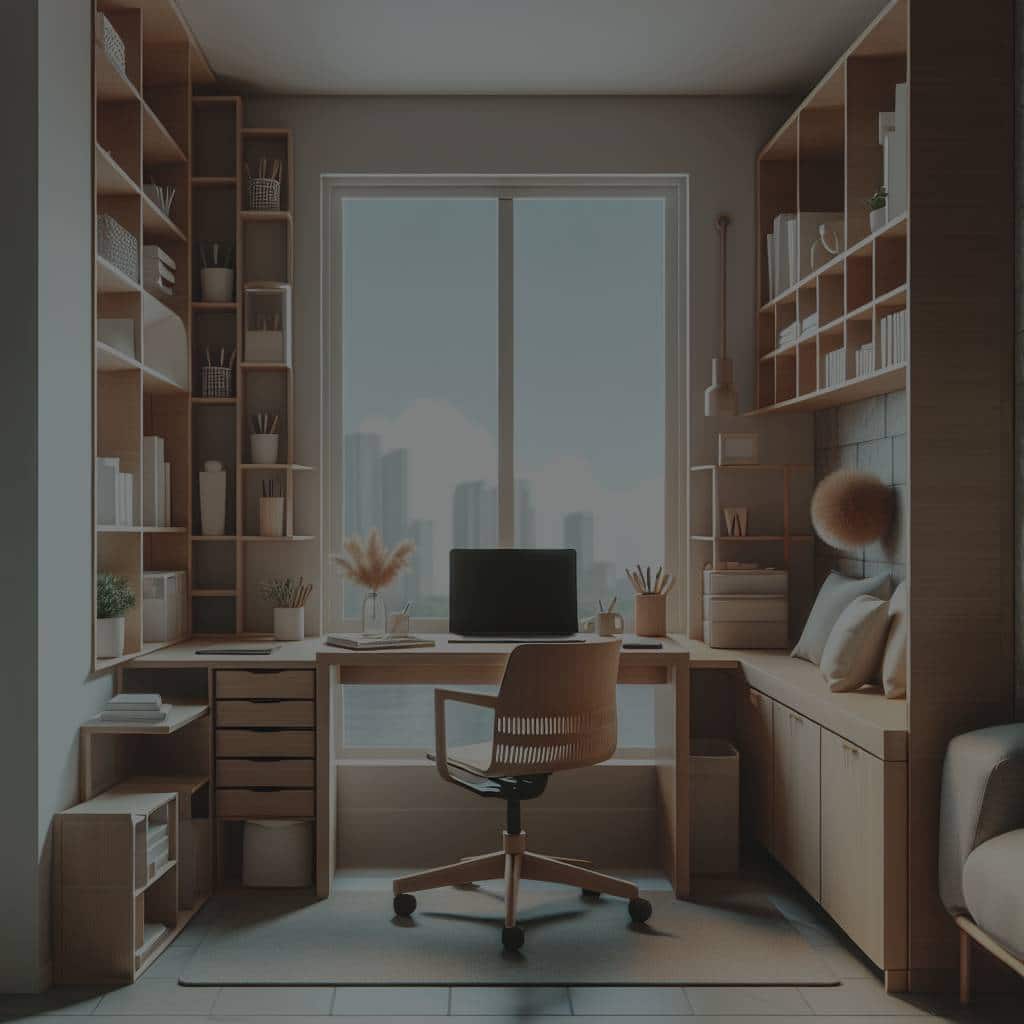What Are the Practical Steps for Setting Up a Work-from-Home Station in a Studio Apartment?

Working from home has become a necessary adaptation for many of us in recent years. As our living spaces have had to double up as our working environments, figuring out how to make the most of a small area has been a significant challenge. This article will guide you through the practical steps of setting up an efficient work-from-home station in a studio apartment. We’ll cover space management, design ideas, and how to make your workspace feel less like your home and more like an office.
Making the Most of Your Space
When your house is your office, every inch counts. In a studio apartment, the challenge is to create an efficient workspace that doesn’t impede on your living area. Start by sketching a rough floor plan of your apartment and designate a specific area as your workspace.
Also to read : How to Choose the Perfect Palette for a Serene Coastal Themed Living Room?
This could be a corner by the window, against a wall, or even in a nook. It’s important to delineate your workspace from your living space; this reinforces a mental boundary between work and leisure, which can help you focus when you’re working and relax when you’re off the clock.
When choosing a desk, opt for one that suits your work style and the space you have. If you’re tight on space, a wall-mounted desk or a small corner table will do. If you need multiple screens or lots of writing space, you might need something larger.
In the same genre : What’s the Best Way to Incorporate Eco-Friendly Geothermal Heating into a Home Renovation?
Storage is crucial in a small space. Look for furniture that doubles up as storage units, like a desk with built-in drawers or shelves. Use wall-mounted shelves to keep your work essentials within reach without taking up desk space. Keep your workspace clutter-free to maintain a clear mind.
Optimizing Design for a Productive Workspace
A good workspace design is not just about aesthetics; it should also foster productivity. Start by considering the layout of your workspace. Make sure your desk is in a place where you will have enough natural light during the day. If that’s not possible, invest in a good desk lamp.
Ergonomics is another important factor. Your chair should be comfortable and supportive, your monitor at eye level, and your keyboard and mouse at a height that allows your arms to be bent at about a 90-degree angle.
There’s also the question of color. Light, neutral colors can help a small space feel larger and more open. Consider painting your workspace wall a soft shade of grey, blue, or even white.
Lastly, add a few personal touches to your workspace. A plant, a piece of artwork, or some decorative items can help make your workspace feel more like yours, which can make working from home a more pleasant experience.
Managing Distractions and Maintaining Boundaries
One of the biggest challenges of working from home is dealing with distractions. In a studio apartment, the line between home and office can blur quickly.
One way to manage distractions is to create a physical boundary between your workspace and the rest of your home. This could be a room divider, a bookshelf, or even a decorative screen.
Noise can also be a significant distraction. If you live in a busy neighborhood, or if the walls in your apartment are thin, consider getting a pair of noise-canceling headphones.
Establish a work schedule and stick to it. Just because your home is your office, it doesn’t mean you have to be working all the time. Set specific working hours and make sure to take regular breaks to stretch, rest your eyes, and hydrate.
Investing in the Right Equipment
No workspace is complete without the right equipment. When you’re working from home, your computer is your most important tool. Make sure it’s up to the task. If it’s slow or unreliable, it could be time for an upgrade.
A good internet connection is also vital. If your current plan isn’t cutting it, it might be worth investing in a faster one, especially if you need to do a lot of video conferencing or data-heavy work.
Don’t forget about software. From project management tools to communication apps, there’s a whole host of software that can make your work-from-home life easier. Be sure to invest in the ones that suit your work needs.
Financing Your Home Office Setup
Setting up a home office can be costly, but there are ways to offset the expense. For one, you may be eligible for tax credit for home office expenses. Check with a tax advisor to see if you can claim any deductions.
If you’re an employee, your company may offer a stipend for home office setup or reimburse you for certain expenses. If you’re self-employed, you can write off part of your rent or mortgage as a business expense.
Remember to keep all receipts related to your home office expenses. These may come in handy when tax season comes around.
Remember, your goal when setting up your work-from-home station in a studio apartment is not just to create a functional space, but also to create a space that fosters productivity and makes your work-from-home experience a positive one. With a little creativity and planning, you can turn even the smallest apartment into a productive and comfortable workspace.
Effective Use of Technology for a Small Home Office
If you’re going to work from home efficiently, your tech setup is paramount. Prioritize investing in a computer that can handle your daily tasks with ease. Lagging or constant system crashes can sabotage your productivity levels, so it’s worth investing in a reliable machine.
Depending on the nature of your work, you might also need other equipment like a printer, scanner, or additional monitors. Consider a multi-functional printer if you are pressed for space.
Internet connectivity is another critical factor for a home office. Ensure you have a stable and high-speed internet connection to facilitate seamless video conferencing and fast downloads. If your studio apartment doesn’t have the best Wi-Fi coverage, consider getting a Wi-Fi extender.
Finally, software tools can significantly enhance your productivity. Apps for project management, communication, file sharing, and time tracking can make your work-from-home experience more efficient. Research and select the tools that are best suited to your work needs.
Creating a Comfortable Environment in Your Home Workspace
Working from home in a studio apartment doesn’t mean you have to sacrifice comfort. Ensure your workstation is ergonomically set up to prevent strain and fatigue. This means getting a comfortable chair that supports your back, positioning your monitor at eye level, and keeping your keyboard and mouse at a height that allows for comfortable typing.
Lighting greatly affects comfort and productivity. Natural light is best, so try setting up your workspace near a window if possible. If natural light isn’t an option, an adjustable desk lamp with a warm light setting can help reduce strain on your eyes.
Introduce elements of nature to your workspace such as indoor plants which can improve air quality and enhance your mood. Don’t forget temperature control; a small desk fan or personal heater can help keep your workspace at a comfortable temperature year-round.
Conclusion: Transforming Your Studio Apartment into a Productive Workspace
Setting up an effective work-from-home station in a studio apartment can be a challenging yet rewarding task. Every square foot counts, and your workspace must be both practical and inspiring. From choosing the right desk and storage solutions to managing distractions and investing in the right technology, each step plays a crucial role in shaping your home office.
Remember, your workspace is more than just a place to complete tasks; it’s where you’ll be spending a significant portion of your day. It should therefore not only promote productivity, but also spark creativity and preserve your wellbeing.
As you embark on this journey, remember to be patient with yourself. It may take time to figure out what works best for you in your office from home. Don’t be afraid to experiment with different setups and refine your workspace as you go. With thoughtful planning and a little creativity, even the smallest studio apartment can become a home office that you’ll love and enjoy working from.
